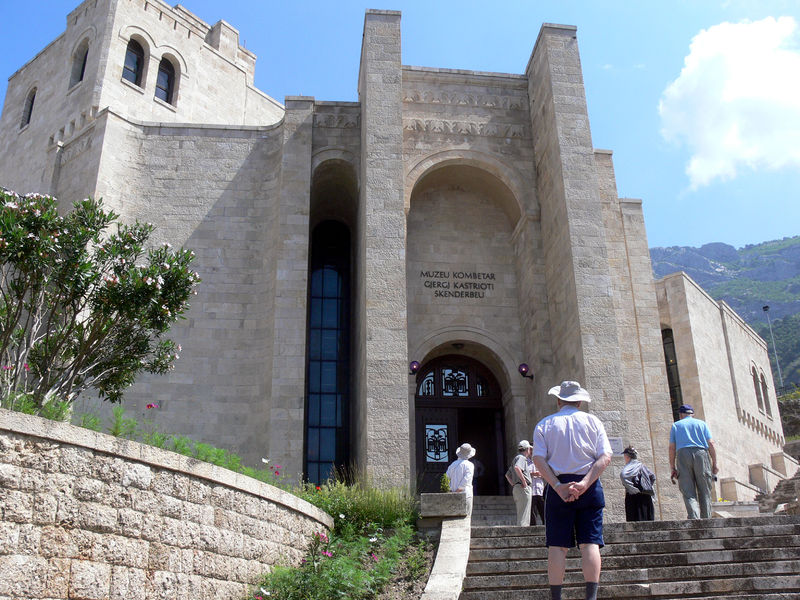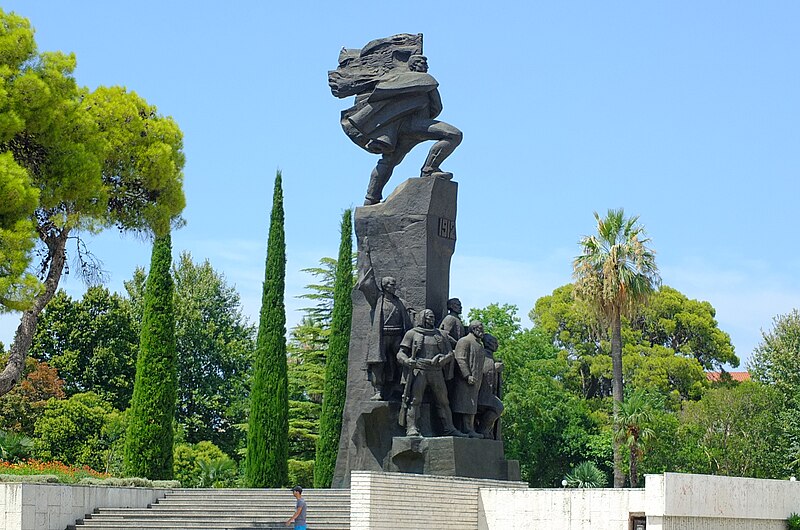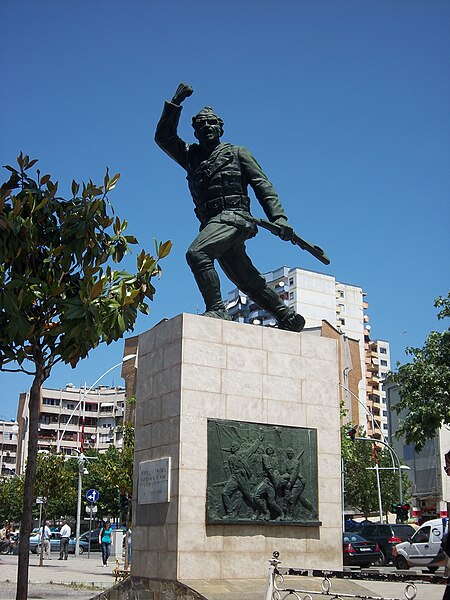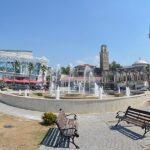Krujë is a beautiful and historic town located in central Albania, just 20 kilometers north of the capital, Tirana. It is a popular tourist destination because of its stunning views of the surrounding mountains and valleys, its rich cultural heritage, and its vibrant local markets. Here are some of the best places and things to do in Krujë
1. Krujë Castle
Image Source: https://en.wikipedia.org/wiki/Castle_of_Kruj%C3%AB
The castle is the most famous attraction in Krujë and is situated on a hilltop overlooking the town. It was built in the 5th century and served as the stronghold of the Albanian resistance against the Ottoman Empire in the 15th century. Visitors can explore the castle walls, towers, and museum which features exhibits on Albanian history and culture.
2. National Park of Qafë Shtama

Image Source: https://en.wikipedia.org/wiki/Shtam%C3%AB_Pass_Nature_Park
The Qafë Shtama National Park is home to several traditional Albanian villages, as well as to important historical sites such as the ruins of a medieval castle and a Roman aqueduct. Visitors to the park can enjoy hiking and trekking along its many trails, as well as birdwatching and exploring its cultural heritage. The park is also a popular destination for camping and picnicking.
3. Skanderbeg Square

Image Source: https://en.wikipedia.org/wiki/Skanderbeg_Square
The square in Tirana has undergone several transformations throughout its history, with the most recent renovation completed in 2017. It is now a pedestrian-friendly area with fountains, gardens, and various statues and monuments, including a statue of Skanderbeg himself.
4. Skanderbeg Museum

Image Source: https://en.wikipedia.org/wiki/Skanderbeg_Museum
The Skanderbeg Museum was opened in 1982 and is housed in Kruja Castle, a historic fortress that dates back to the 5th century. The museum’s exhibits include weapons, armor, and other artifacts related to Skanderbeg’s life and military campaigns, as well as exhibits related to the history and culture of Albania more broadly.
5. Ethnographic Museum of Kruja

Image Source: https://www.tripadvisor.in/Attraction_Review-g469423-d6652812-Reviews-Ethnographic_Museum_of_Kruja-Kruje_Durres_County.html
The museum’s exhibits include a wide range of artifacts related to traditional Albanian culture, including clothing, jewelry, household items, and agricultural tools. Visitors can learn about traditional crafts such as weaving, embroidery, and woodcarving, as well as the history and customs of the region’s various ethnic groups.
6. Xhamia e Et’hem Beut in Tirana

Image Source: https://sq.wikipedia.org/wiki/Xhamia_e_Et%27hem_Beut
The mosque was built in the early 19th century by Et’hem Bey, a prominent Ottoman-era Albanian nobleman and leader. It is renowned for its intricate decorative details, including the frescoes and calligraphy that adorn its walls and ceiling. These decorations are particularly notable as they are quite rare in Islamic art, where images of living beings are often discouraged.
7. Preza Castle

Image Source: https://en.wikipedia.org/wiki/Prez%C3%AB_Castle
The castle is situated on a hilltop overlooking the surrounding countryside and was strategically important as a defensive fortress during various periods of Albanian history. It consists of several towers and walls, as well as a central keep, which was used as a residence for the castle’s lords.
8. Orthodox Autocephalous Church

The Albanian Orthodox Church was established in 1922, after Albania declared independence from the Ottoman Empire. It was recognized as an autocephalous church by the Ecumenical Patriarchate of Constantinople in 1937. The church went through a period of suppression and persecution under communist rule in Albania, but regained its independence and prominence after the fall of communism in 1991.
9. Clock Tower

Image Source: https://en.wikipedia.org/wiki/Clock_tower
Clock towers are an important part of Albania’s cultural heritage and are popular destinations for visitors who want to learn more about the country’s history and architecture. Clock Tower was built in the early 19th century and is a symbol of the city’s history and culture. It was damaged during World War II but was restored in the 1990s and is now a popular tourist attraction.
10. Tanners’ Bridge in Tirana
Image Source: https://en.wikipedia.org/wiki/Tanners%27_Bridge
The bridge is notable for its unique architecture, which features stone arches and a series of small niches and alcoves along the sides of the bridge. These alcoves were used by the tanners to store their leather goods while they were being transported across the bridge.
11. Mount Dajti in Tirana

Image Source: https://en.wikipedia.org/wiki/Dajti
The mountain rises to an elevation of 1,613 meters (5,292 feet) and is part of the Dajti National Park, which covers an area of over 29,000 hectares (71,660 acres). The park is home to a wide range of flora and fauna, including oak, beech, and pine forests, as well as wild boar, foxes, and deer.
12. Postbllok – Checkpoint Monument in Tirana

Image Source: https://www.tripadvisor.in/Attraction_Review-g294446-d12065282-Reviews-Postbllok_Checkpoint_Monument-Tirana_Tirana_County.html
The monument is covered in graffiti and is often used as a gathering place for protests and political rallies. In 2017, the area around the monument was renovated and turned into a museum and park, with exhibits highlighting Albania’s communist past and its transition to democracy.
13. Unknown Partisan Monument
Image Source: https://en.wikipedia.org/wiki/Unknown_Soldier_(statue)
The monument consists of a large rectangular block of concrete with a bronze statue of a Partisan fighter on top. The statue depicts a male Partisan fighter holding a rifle in his hand and wearing a uniform and a cap. The concrete block has the inscription “Lavdi dëshmorëve të kombit” (Glory to the martyrs of the nation) and is surrounded by several smaller stones with the names of the districts where Partisans fought and died during the war.
14. Independence Monument

Image Source: https://en.wikipedia.org/wiki/Independence_Monument_(Albania)
The monument is made of concrete and stands 12 meters tall. It consists of a large circle with a map of Albania in the center, surrounded by 28 pillars that represent the country’s districts. The pillars are inscribed with the names of the districts and their dates of liberation from Ottoman rule.
15. Fortress of Justinian

Image Source: https://www.tripadvisor.com/Attraction_Review-g294446-d318521-Reviews-Fortress_of_Justinian-Tirana_Tirana_County.html
Fortress of Justinian is a popular tourist attraction and an important symbol of Albania’s rich cultural heritage. Visitors can explore the fortress and its walls, towers, and gates, and take in the stunning views of the surrounding landscape. The fortress is also home to a museum that displays artifacts and exhibits related to the region’s history and culture.
Krujë is a charming town that has something for everyone, from history and culture to nature and cuisine. Its location close to Tirana makes it a perfect day trip, but it’s worth staying longer to fully explore all the attractions and activities that the town has to offer.
Places and Things To Do










